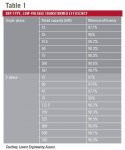electrofelon
Senior Member
- Location
- Cherry Valley NY, Seattle, WA
Anyone want to throw out a guess of what a typical dry type single phase 15 kva transformer would draw just sitting there with no load? Is there a rule of thumb for this? Anyone ever measured this (not necessarily with that specific KVA)?


